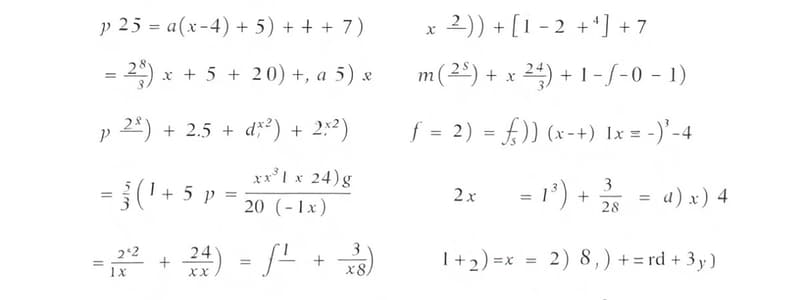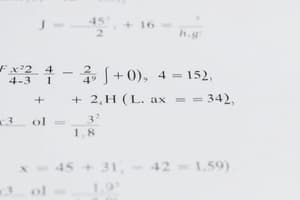Podcast
Questions and Answers
What is the correct form of a quadratic equation?
What is the correct form of a quadratic equation?
- y = mx + b
- y = b^x
- ax + b = 0
- ax² + bx + c = 0 (correct)
Which rule is used to find the derivative of the product of two functions?
Which rule is used to find the derivative of the product of two functions?
- Sum rule
- Product rule (correct)
- Chain rule
- Quotient rule
In the unit circle, which point corresponds to an angle of π radians?
In the unit circle, which point corresponds to an angle of π radians?
- (0, 1)
- (1, 0)
- (0, -1)
- (-1, 0) (correct)
What is the area of a circle with a radius of 5 units?
What is the area of a circle with a radius of 5 units?
Which of the following measures central tendency?
Which of the following measures central tendency?
How do you denote the limit of a function as x approaches a?
How do you denote the limit of a function as x approaches a?
What is the formula for the volume of a cylinder?
What is the formula for the volume of a cylinder?
What is the range of a function?
What is the range of a function?
Flashcards are hidden until you start studying
Study Notes
Algebra
-
Basic Concepts:
- Variables, constants, coefficients
- Expressions and equations
- Order of operations (PEMDAS/BODMAS)
-
Types of Equations:
- Linear equations: Form y = mx + b
- Quadratic equations: Form ax² + bx + c = 0, solutions via factoring, completing the square, or quadratic formula.
- Polynomial equations: Sum of monomials.
-
Functions:
- Definition: Relation between input and output
- Types: Linear, quadratic, exponential, logarithmic
- Domain and range: Possible input and output values.
Calculus
-
Limits:
- Definition: Value function approaches as input approaches a point.
- Notation: lim (x → a) f(x).
-
Derivatives:
- Concept: Rate of change or slope of the tangent line.
- Notation: f'(x) or dy/dx.
- Rules: Product rule, quotient rule, chain rule.
-
Integrals:
- Definition: Area under a curve or accumulation of quantities.
- Indefinite integrals: ∫f(x)dx + C.
- Definite integrals: ∫[a, b] f(x)dx, computation using limits.
Trigonometry
-
Basic Ratios:
- Sine (sin), Cosine (cos), Tangent (tan): Ratios of sides in a right triangle.
-
Unit Circle:
- Angles measured in radians (360° = 2π radians).
- Key points: (1,0), (0,1), (-1,0), (0,-1) corresponding to 0, π/2, π, and 3π/2 radians.
-
Identities:
- Pythagorean identities: sin²(x) + cos²(x) = 1.
- Angle sum and difference identities: e.g., sin(a ± b) = sin(a)cos(b) ± cos(a)sin(b).
Geometry
-
Shapes and Properties:
- Triangles: Types (isosceles, equilateral, scalene) and the Pythagorean theorem: a² + b² = c².
- Circles: Definitions, angles, arc lengths, area (A = πr²), circumference (C = 2πr).
-
Geometric Proofs:
- Two-column proofs: Statements and reasons to establish truths.
- Congruence and similarity: Conditions for triangles (SSS, SAS, AAS).
-
Volume and Surface Area:
- Prisms: Volume = base area × height.
- Cylinders: Volume = πr²h, Surface area = 2πrh + 2πr².
Statistics
-
Descriptive Statistics:
- Measures of central tendency: Mean, median, mode.
- Measures of dispersion: Range, variance, standard deviation.
-
Probability:
- Definition: Likelihood of an event occurring, 0 ≤ P(A) ≤ 1.
- Rules: Addition rule, multiplication rule, complementary rule.
-
Distributions:
- Normal distribution: Bell curve, properties of mean and standard deviation.
- Binomial distribution: Discrete outcomes, defined by trials and success probability.
-
Hypothesis Testing:
- Null hypothesis (H0) vs. alternative hypothesis (H1).
- p-value: Probability of observing the data, given H0 is true; significance level α.
-
Correlation and Regression:
- Correlation coefficient (r): Measure of linear relationship between two variables.
- Linear regression: Modeling relationships, form y = mx + b + error term.
Basic Concepts
- Variables: Represent unknown quantities, often denoted by letters (e.g., x, y)
- Constants: Fixed values, not changing (e.g., 5, -2)
- Coefficients: Numbers multiplying variables (e.g., 3 in 3x)
Expressions and Equations
- Expressions: Combinations of variables, constants, and operations, e.g., 2x + 5
- Equations: Set two expressions equal to each other, e.g., 2x + 5 = 11
Types of Equations
- Linear Equations: Graph as straight lines, represented by y = mx + b, where m is the slope and b is the y-intercept
- Quadratic Equations: Equations with highest degree 2, form ax² + bx + c = 0 (a≠0), can be solved by factoring, completing the square, or the quadratic formula.
- Polynomial Equations: Sum of monomials (terms with variables raised to non-negative integer powers)
Functions
- Definition: A rule that assigns each input (x) to a unique output (y)
- Linear Function: Graph as a straight line, equation y = mx + b
- Quadratic Function: Graph as a parabola, equation y = ax² + bx + c (a≠0)
- Exponential Function: Graph as a curve with increasing or decreasing growth, equation y = ab^x (a≠0, b≠0, b≠1)
- Logarithmic Function: Inverse of an exponential function, equation y = log_b(x)
- Domain: Set of all possible input values (x)
- Range: Set of all possible output values (y)
Limits
- Definition: The value a function approaches as its input gets closer and closer to a specific point
- Notation: lim (x → a) f(x)
Derivatives
- Concept: The instantaneous rate of change of a function, or the slope of the tangent line at a specific point
- Notation: f'(x) or dy/dx
- Rules: Product rule, quotient rule, chain rule used to find the derivative of complex functions
Integrals
- Definition: The area under a curve or the accumulation of quantities
- Indefinite Integrals: An integral without specific limits, denoted by ∫f(x)dx + C (C represents constant of integration)
- Definite Integrals: An integral with specific limits, denoted by ∫[a, b] f(x)dx
Basic Ratios
- Sine (sin) = Opposite side / Hypotenuse
- Cosine (cos) = Adjacent side / Hypotenuse
- Tangent (tan) = Opposite side / Adjacent side
Unit Circle
- Angles: Measured in radians (360° = 2π radians)
- Key Points: (1,0), (0,1), (-1,0), (0,-1) corresponding to 0, π/2, π, and 3π/2 radians respectively
Identities
- Pythagorean Identities: sin²(x) + cos²(x) = 1
- Angle Sum and Difference Identities: e.g., sin(a ± b) = sin(a)cos(b) ± cos(a)sin(b)
Shapes and Properties
- Triangle: Three-sided polygon, types: isosceles, equilateral, scalene
- Pythagorean Theorem: In a right triangle, a² + b² = c² (where a and b are legs, c is the hypotenuse)
Geometric Proofs
- Two-column proofs: Organize statements and reasons to justify claims
- Congruence: Two figures with identical size and shape
- Similarity: Two figures with the same shape, but potentially different sizes
Volume and Surface Area
- Prisms: Volume = base area × height
- Cylinders: Volume = πr²h, Surface area = 2πrh + 2πr²
Descriptive Statistics
- Measures of Central Tendency: Mean (average), Median (middle value), Mode (most frequent value)
- Measures of Dispersion: Range (difference between highest and lowest values), variance (average squared deviation from the mean), standard deviation (square root of the variance)
Probability
- Definition: Likelihood of an event occurring, value between 0 and 1 (inclusive)
- Rules: Addition rule (for mutually exclusive events), multiplication rule (for independent events), complementary rule (probability of an event not occurring)
Distributions
- Normal Distribution: Shaped like a bell curve, characterized by its mean and standard deviation
- Binomial Distribution: Represents the probability of a specific number of successes in a series of independent trials
Hypothesis Testing
- Null Hypothesis (H0): Statement of no effect or no difference
- Alternative Hypothesis (H1): Statement of an effect or difference
- p-value: Probability of observing the obtained results if the null hypothesis is true
- Significance Level (α): Threshold for rejecting the null hypothesis (typically 0.05)
Correlation and Regression
- Correlation Coefficient (r): Measures strength and direction of linear relationship between two variables (-1 to 1)
- Linear Regression: Process of finding a linear equation to model the relationship between variables, represented by y = mx + b + error term
Studying That Suits You
Use AI to generate personalized quizzes and flashcards to suit your learning preferences.




